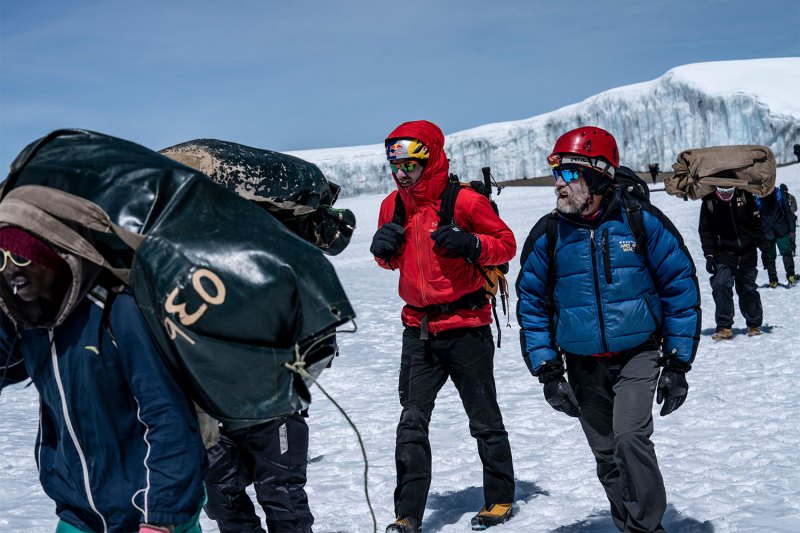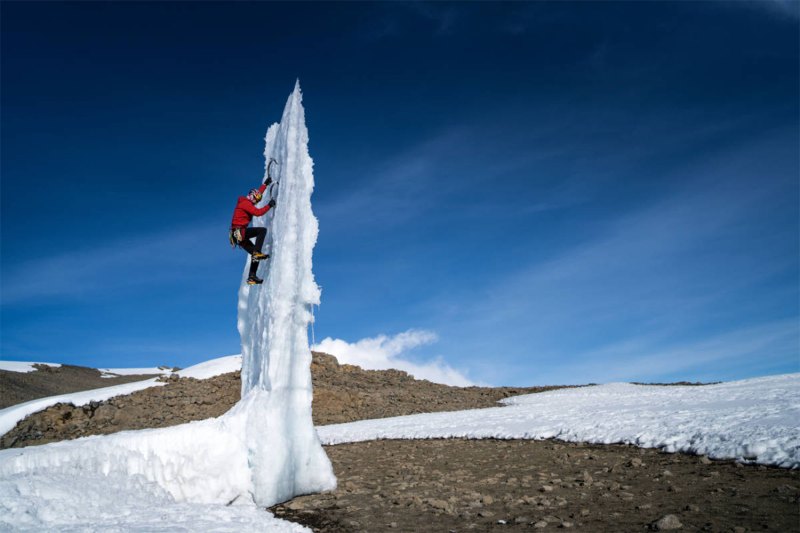If you want to learn about the snow-capped summit of Mount Kilimanjaro, Africa’s tallest summit, don’t bother reading Ernest Hemingway’s 1936 short story, “The Snows of Kilimanjaro,” because he doesn’t dwell much on the 19,341-foot tall mountain.
And if you want to see said summit while still snow-capped, you might want to move fast. As witnessed firsthand by world renowned ice climber (and paraglider, paddler, and general adventure type) Will Gadd, Kili’s glaciers are fast disappearing and are unlikely to re-form.
Thus the doleful title of the short film just released by Red Bull — The Last Ascent — that chronicles Gadd’s climb of Mount Kilimanjaro.
A somber reversal of the loftiest goal of serious climbers, which is completing the first ascent of a new route up a mountain or ice formation, Last Ascent follows Gadd on two climbing expeditions to the glaciers of Kilimanjaro. The first was in 2014, when the ice was shrinking but remained robust; the second was in February of 2020, when Gadd returned and climbed what little was left of the ice route first completed by Reinhold Messner in 1978. In just six years, the permanent ice formations atop the mountain were all but gone, melted by a warming world and unlikely to return for several lifetimes to come.
It was a climb that Gadd had spent much of his lifetime preparing for, and one he knew in the moment would change his views on the world for the rest of his life.
“I grew up in the Canadian Rockies climbing with my parents, I played just about every sport, but really mountain sports were what always called me,” Gadd tells The Manual. “I went to school to be a lawyer but realized I didn’t want to be a lawyer. So I got a job as a writer and editor with a few places, I started a couple companies, but then I decided to quit all that so I could climb icicles and fly my paraglider. Everyone told me it was a pretty stupid idea, but 25 years later, things are still going pretty well. I basically climb, fly, paddle, as much as I can all over the world.”

As a paddler, Gadd isn’t a tip-of-the-podium kind of guy. But as a climber and flier, he is. Gadd has completed multiple first ascents of ice climbing routes and set a work record for long distance paraglider flight (263 miles!) and in fact flew off the summit of Mount Kilimanjaro under his paraglider. He has established new routes climbing the ice of Niagara Falls, established new routes in China, Greenland, and closer to home in British Columbia, and has won the Canadian National Sport-Climbing Championships four times (so far).
He leads aspiring climbers on rock and ice and has introduced hundreds of people to mountain sports as a guide and coach, and also always seeks to instill in those he meets a genuine concern over the fact that our world is warming up. Over the course of his storied career, his close relationship with ice has always put climate change front and center in his mind.”
“The first time I really started to realize climate change was an issue was when I was a kid,” (Gadd was 53 at the time of this interview, FYI) “and I was looking at this map while out on a ski tour, and I’m looking for this glacier, and there just isn’t a glacier. I’m looking at the map, thinking I’m reading it wrong, and then I realize the glacier just isn’t there. It had retreated miles up the valley. Where I’ve worked and lived daily since, I’ve just seen ice retreating every year, and just disappearing. And then globally we see the same thing happening everywhere. Everywhere I go in the world, people say we see our ice season shrinking — it’s four months, then all the sudden it’s two months.”
“Back in 2014, when I first went to Kilimanjaro, it was the same thing. We had maps showing where the ice was, and most of the time it just wasn’t. So we’re wandering around in this high altitude desert that used to be under a glacier. It was shocking to me how quickly it was changing.”

With The Last Ascent, which Gadd considers equally “a short film and a climate film,” he and the producers hope to make the reality of the climate change issue more tangible. And to show some damn good climbing, too.
“I hope people watch it and maybe people who live in a big city and don’t have glaciers out their back door who just don’t feel the changes in the same way,” he says. “I mean maybe your summer is hotter and longer, but then when you see this film, when you look at the images in this film, and the comparison shots, I hope it gets people to think a little bit. These trips changed my life and my approach to climate change, and maybe it can do that a bit for others.”
Gadd will keep spreading his message of awareness and action against climate change far and wide, and for his own part he is trying to make changes as well. “I mean I haven’t solved these problems for myself, I’m just wrestling with them. I am trying to change my life around. I’m committed to reducing my carbon footprint, being aware of what I’m putting into the atmosphere. I’m traveling more consciously than I did five years ago. I’m just trying to be better.”
It might be too late for the ice on Kili, but if we all do the same, strive to be better, maybe future generations will again see Africa’s crown crested with glaciers.



